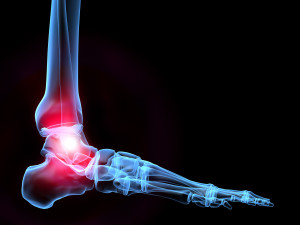 Many people do not realize how important it is to get prompt treatment for a sprained ankle, an estimated 55% of people who suffer this type of injury do not seek treatment. A report on the US National Library of Medicine National Institutes of Health website states that most of us do not attach much significance to an ankle sprain but up to 75% will go on to have repeated sprains and develop chronic symptoms.
Many people do not realize how important it is to get prompt treatment for a sprained ankle, an estimated 55% of people who suffer this type of injury do not seek treatment. A report on the US National Library of Medicine National Institutes of Health website states that most of us do not attach much significance to an ankle sprain but up to 75% will go on to have repeated sprains and develop chronic symptoms.
Types of Ankle Sprain
The most common type of sprained ankle is an ‘inversion sprain’ where the foot has twisted inward, damaging the ligaments that support the ankle.
Sprains fall into three basic categories:
1. Minor: Some stretching of the ligament resulting in minor discomfort, some swelling but no instability
2. Moderate: Tearing of the ligament resulting in moderate swelling, some instability and pain on walking that can vary between moderate and severe
3. Severe: A complete tear of the ligament resulting in severe swelling and pain and the inability to weight-bear on the ankle affected.
Symptoms can include pain around the knee as well as localized pain and more severe sprains can be associated with bone fractures.
Who Is Most at Risk of Ankle Sprain?
Because the force on our ankle joints when walking or running can be more than seven times our body weight, carrying extra weight can increase the likelihood of getting a sprained ankle. In fact, being overweight or a having had a previous ankle sprain are the main factors in predicting a future injury of this type.
Walking or running on uneven surfaces or playing sports that involve rapid changes in direction are common causes of injury. However, there are many other factors, including high arches, balance or coordination problems, tight calf muscles and poor or reduced cardiovascular fitness. For women, another common cause is wearing high-heeled shoes.
For those who have suffered a previous ankle sprain, incorrect or incomplete healing can result in gait problems. Not clearing the ground correctly during the forward swing of the leg or an excessive, frequent inward tilting of the foot when walking or running can increase the risk of re-injury.
Don’t ‘Tough it Out’
There is quite a lot you can do immediately after an ankle injury that will help; for example, using ice wrapped in a cloth to relieve pain and inflammation for up to twenty minutes at a time. However, trying to ‘tough it out’ and not getting correct care for your ankle could be a very bad move in the long term, increasing the risk of re-injury, chronic symptoms or even an injury to the other leg which may be put under more strain, compensating for any weakness left after an ankle sprain.









